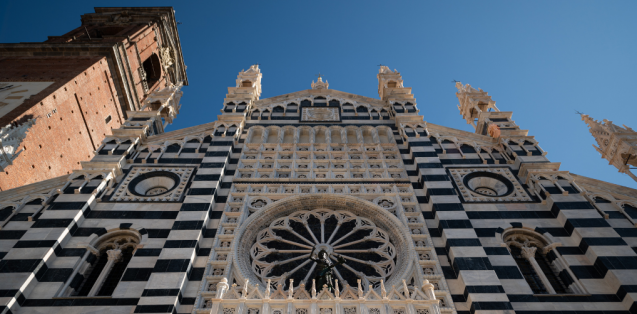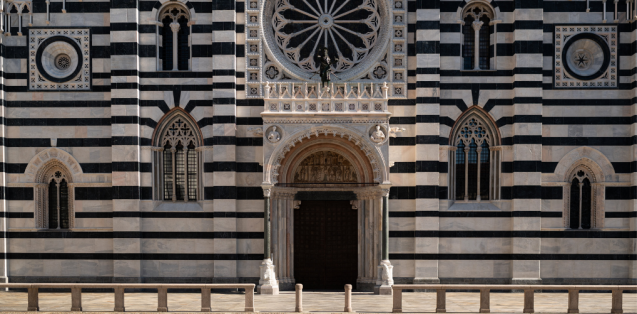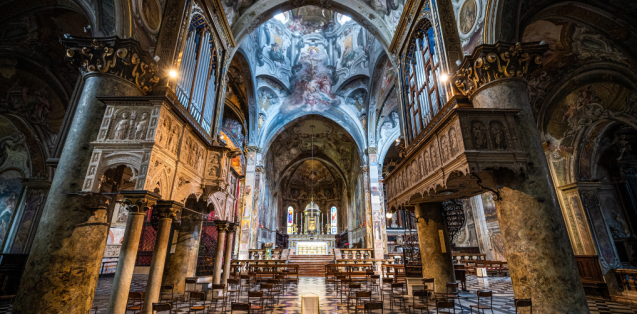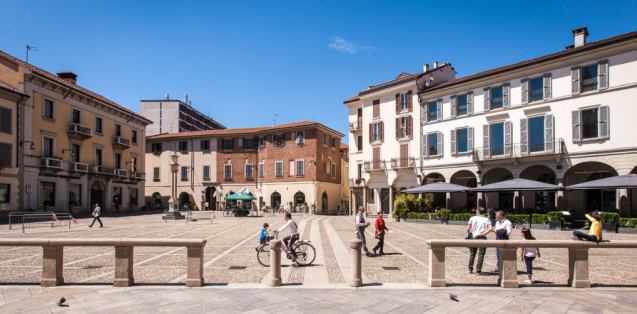The Duomo and its square were the centre of the religious and political life in Monza: the ancient town developed around its primary core, probably the “oraculum” founded by the Queen Teodolinda in the 6th century. ‘Il Duomo’, dedicated to San Giovanni Battista (John the Baptist), is the town’s most important monument. The present building stands on the site where, around the year 595, Queen Theodelinda built a basilica. According to a medieval legend, Queen Theodelinda chose the site because it was indicated to her, in a dream, by a dove: the joining of the words ‘Modo’ (here) and ‘Etiam’ (yes) – spoken respectively by the dove and Theodelinda – gave origin to the ancient name of the town, Modoetia.
Built as a royal chapel, the church survived until 1300, when it was felt that renovation was needed: work on the new basilica began on 31st May 1300. The total reconstruction took place in two stages. The first ended in 1346 with the consecration of the high altar: the building was in Latin cross shape, with three aisles, projecting transept, flat apse and three-section façade crossed with lines of black and white marble. The side chapels and two large symmetrical polygonal chapels in the apse area were built at a later date, in the second half of the 14th century, under the supervision of the architect and sculptor Matteo da Campione (d. 1396), who also widened the façade and added a pulpit and a baptistery (now lost).
Artists such as Arcimboldo, Legnanino, Borroni and Carloni embellished the basilica in the following centuries. Pellegrino Tibaldi rebuilt the choir, laid upon a large crypt, while the colossal bell-tower, built starting from 1592, is due to the collaboration with Ercole Turati. To the left of the main altar is the Chapel of Teodolinda, whose mural paintings by the Zavattari, a masterpiece of international Gothic style of the mid15th century, represent devotion and a tribute to the Queen. The Chapel houses the Iron Crown, considered over the centuries as a symbol, a legend and one of the most important and meaningful goldsmiths’ works of the Christian history. Indeed, an ancient tradition wants the ring inside the crown to be obtained from one of the nails used for Jesus’ crucifixion. There were many coronations of kings and emperors with the Iron Crown, including Charlemagne and Napoleon.
FAÇADE AND PORCH
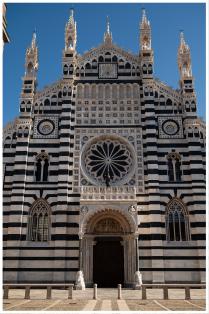 Recently brought back to its original aspect, the façade of the Duomo of Monza distinguish itself for the two-toned marble, which now is possible to appreciate like it looked like at the end of the 19th century. Then, precisely starting from 1890, in fact, began a restoration work lead by Luca Beltrami, who rebuilt the top aedicules - all already fallen except for one - and decided to replace the former black marble of Varenna with a green serpentine of Oira, to underline the Tuscan origin of Matteo da Campione's art. This work altered significantly the colours of the façade of the Duomo. Nevertheless, they had been recovered in 2020 with a maintenance work which interested also the rose window and the ornamental reliefs.
Recently brought back to its original aspect, the façade of the Duomo of Monza distinguish itself for the two-toned marble, which now is possible to appreciate like it looked like at the end of the 19th century. Then, precisely starting from 1890, in fact, began a restoration work lead by Luca Beltrami, who rebuilt the top aedicules - all already fallen except for one - and decided to replace the former black marble of Varenna with a green serpentine of Oira, to underline the Tuscan origin of Matteo da Campione's art. This work altered significantly the colours of the façade of the Duomo. Nevertheless, they had been recovered in 2020 with a maintenance work which interested also the rose window and the ornamental reliefs.
The chromatism of the marble with white and green stripes, the rose window, the mullioned windows, the Lombard bands, the aediculae and the spires, exhibit the power and dignity of the Church in Monza.The façade is made up of five bays, separated by four pilasters and enclosed by two buttresses. The façade is decorated with small steepled aedicules with the statues of six saints. Double-, triple-lancet and lacunar-framed circular windows add to the façade’s beauty while, above these, can be seen a false hanging loggia. In the central section, there is Matteo da Campione’s rose window – restored by Luca Beltrami – enclosed in a complex circular frame and set in a square of small decorative panels with faces, flowers and stars; above this, the motifs around the rose window are repeated. The bearded head (14th century) over the double-lancet window in the northern-most section of the façade is said to be that of Matteo da Campione. The prothyrum (porch) is in Renaissance style: the two medallions of the archway contain early-16th-century busts of Theodelinda and her bridegroom, Agilulf; above is the bronze copy of the statue of John the Baptist, the 14th-century embossed copper original of which is kept in the cathedral museum. Behind John the Baptist can be seen items of the cathedral Treasury: the Hen with seven chicks, the Cross of the Kingdom and the small Sapphire Cup. Discover the originals at the Museum and Treasure of the Duomo of Monza
THE INTERIOR OF THE DUOMO
Inside, the cathedral has a Latin cross plan with three aisles. Octagonal columns with capitals featuring wild animals, eagles, telamones, griffins, sirens and centaurs separate the aisles while the semi-capitals of the transverse arch show Christ and the Evangelists. The walls are decorated with the portraits of Longobard kings and emperors believed to have been crowned with the Iron Crown. On the end wall of the right transept, there is the Tree of Life, frescos by Giuseppe Arcimboldi and Giuseppe Lomazzo (known in Italy as ‘il Meda’) dating back to 1556.
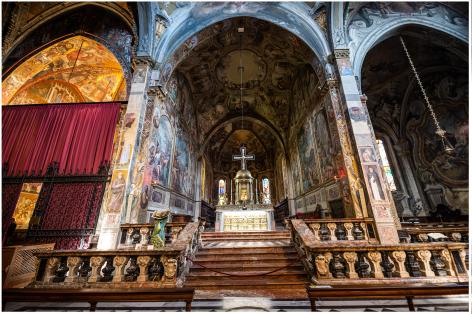 The high altar, built between 1793 and 1798 by Andrea Appiani, is in marble and gilded bronze with amethyst and lapis lazuli inserts. The frontal, at the centre of the presbytery, is a masterpiece of Lombard Gothic craftsmanship: the decoration tells the life of John the Baptist and, at the centre, depicts the Baptism of Christ. The stories of John the Baptist are also depicted on the walls of the choir.
The high altar, built between 1793 and 1798 by Andrea Appiani, is in marble and gilded bronze with amethyst and lapis lazuli inserts. The frontal, at the centre of the presbytery, is a masterpiece of Lombard Gothic craftsmanship: the decoration tells the life of John the Baptist and, at the centre, depicts the Baptism of Christ. The stories of John the Baptist are also depicted on the walls of the choir.
To the left of the presbytery is the Chapel of Theodelinda, with mural paintings from the first half of the 15th century by the Zavattaris depicting stories from the life of Queen Theodelinda, an undisputed masterpiece of Gothic art. On the entrance arch can be seen John the Baptist blessing Theodelinda, Autari, Agilulf and Adaloald. Close to the queen, there is a dove and the word ‘Modo’, while Theodelinda replies ‘Etiam’: the two words, according to a medieval legend, gave origin to the ancient name of Monza, Modoetia. The remains of Queen Theodelinda lie in a sarcophagus behind the altar. The Iron Crown is kept in the tabernacle of the altar in the Chapel of Theodelinda, constructed during the restoration work by Luca Beltrami (1892-95): it is among the best-known artefacts of the Longobard period.
BELL TOWER
The bell tower of the Cathedral was erected between the 16th and 17th century. It is 78 metres high and was built according to the designs of Ercole Turati between 1592 and 1620: sculpted in the medallions decorating the belfry are the Lamb on the book of the seven seals, the Hen with seven chicks, the Mitre and pastoral staff, the Iron Crown and the Cross of the Kingdom.
PIAZZA DUOMO
The geographic centre of the town, the cathedral square is not actually square in shape, with one side taken up entirely by the facade of the cathedral (the Duomo). The present structure dates back to the 15th century and is the result of the demolition of the medieval houses that occupied an area that extended right up to just a few metres from the cathedral parvis. Near the middle of the square is the ‘Crocetta’, a cross erected in 1578 to indicate the position of an altar for evening prayers during the plague of San Carlo (1576-77). Opposite the cathedral stands the 14th-century Palazzo degli Arcipreti (Palace of the Archpriests). Entry to the Rectory (‘Canonica’) is through the neo-Gothic arch to the right of the façade. The square is now part of the centre’s pedestrianised area and is used as a venue for a variety of events.


